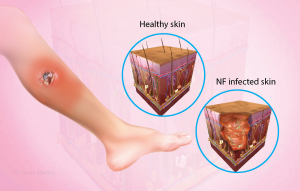
Necrotising fasciitis of the foot, also known as flesh-eating disease, is a rare but serious bacterial infection that affects the soft tissue beneath the skin, including the fascia and muscle. It is a medical emergency that requires immediate treatment.
Necrotising fasciitis of the foot can occur after an injury or a surgical procedure on the foot, but in some cases, it can occur spontaneously without any apparent cause. The bacteria responsible for the infection are usually Streptococcus or Staphylococcus, which can enter the body through a cut or wound on the foot.
Symptoms of necrotising fasciitis of the foot include:
- Pain and swelling in the affected area
- Redness or discolouration of the skin
- Blisters or skin lesions that rapidly spread
- Fever and chills
- Nausea and vomiting
If you suspect you have necrotising fasciitis of the foot, it is important to seek medical attention immediately. Treatment typically involves surgery to remove the infected tissue, along with intravenous antibiotics and supportive care. In severe cases, amputation may be necessary to prevent the spread of the infection. Early diagnosis and treatment are critical for a successful outcome.
